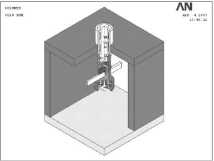6355787712
Diagnostyka’ l(45)/2008
GUMIŃSKI, JASIŃSKI, RADKOWSKI, Small-Sized Test Bedfor Diagnosing...
accompanies the growth of the crack’s length, which in tum has influence on the amplitudę of the sample end’s speed [2],
K = f(e,E,a,W,Yu,Yv) (1)
where:
Yu =f(a,W),
Yv = f(a,W)
The publications [1] include various test-beds which depend on the type of research.
3. SMALL-SIZED TEST-BED
The test-beds enabling gigacycle fatigue tests usually enable three-point bending with the sample set on two supports mounted on a foundation.
From the point of view of fatigue-related destruction of a tooth, the authors propose a test-bed for examining gigacycle fatigue-related processes for two-point bending. For the maximum deformation in the rangę 5+40 pm and the generated freąuency of ca. 10kHz, a system has been selected that can be powered with 230V current. It is a piezoelectric generator PPA40XL (Fig. 1) which interworks with LA75C power supply unit.

Fig. 1. Piezoelectric generator
PPA40XL
|
1 | |||
|
I | |||
Fig. 2. Own vibration freąuency depending on beam length
The preliminary dimensions were calculated of the sample (WxHxL): 5mm x lOmm x 30mm while assuming that resonance vibration eigenfreąuency for the sample eąuals 10 kHz (Fig. 2). The beam can be madę of titanium or high ąuality Steel.
As was mentioned in item [2], the typical test-beds for gigacycle research usually rely on the frames of machines used for tests of fatigue life. These test-beds have relatively big dimensions and weight. The authors have designed a small-size test-bed for diagnosing the gigacycle fatigue-related processes (Fig. 3). The test-bed has the form of a cube with dimensions of 0.3x0.3x0.3 m and its weight does not exceed 10 kg. The head is madę of titanium and mounted directly in the piezoelectric generator. The beam is mounted with the use of an circular cam (in order to do away with play). Smali dimensions have been proposed to enable mounting the test-bed on TIRA TV 5500/LS shaker (Fig. 4) having the following parameters: nominał load -4000 N, freąuency rangę DC+3000 Hz, maximum acceleration 54 g. Use of the shaker will enable generation of freąuencies that modulate the beam’s yibration eigenfreąuency, thus enabling examination of morę complex mechanisms of fatigue-related crack initiation and development.

Fig. 3. Small-sized test-bed for diagnosing gigacycle fatigue-related processes
Wyszukiwarka
Podobne podstrony:
10 Diagnostyka’ l(45)/2008 GUMIŃSKI, JASIŃSKI, RADKOWSKI, Small-Sized Test Bedfor
Diagnostyka’ l(45)/2008 GUMIŃSKI, JASIŃSKI, RADKOWSKI, Small-Sized Test Bedfor
Diagnostyka’ l(45)/2008 GUMIŃSKI, JASIŃSKI, RADKOWSKI, Small-Sized Test Bedfor Diagnosing... broader
Diagnostyka’ l(45)/2008 GUMIŃSKI, JASIŃSKI, RADKOWSKI, Small-Sized Test Bedfor Diagnosing... into
Diagnostyka’ l(45)/2008 GUMIŃSKI, JASIŃSKI, RADKOWSK1, Small-Sized Test Bedfor Diagnosing... Fig. 4.
Diagnostyka’ l(45)/2008 RYBCZYŃSKI, Maps offolerable Misalignments of Bearings Applicable...MAPS OF
12 Diagnostyka’ l(45)/2008 RYBCZYŃSKI, Maps ofTolerable Misalignments of Bearings
Diagnostyka’ l(45)/2008 13 RYBCZYŃSKI, Maps ofTolerable Misalignments of Bearings
14 Diagnostyka’ l(45)/2008 RYBCZYŃSKI, Maps ofTolerable Misalignmenls of Bearings
Diagnostyka’ l(45)/2008 15 RYBCZYŃSKI, Maps ofTolerable Misalignmenls of Bearings
16 Diagnostyka’ l(45)/2008 RYBCZYŃSKI, Maps ofTolerable Misalignmenls of Bearings
Diagnostyka’ l(45)/2008 17 RYBCZYŃSKI, Maps ofTolerable Misalignmenls of Bearings
18 Diagnostyka’ l(45)/2008 _RYBCZYŃSKI, Maps ofTolerable Misa/ignments ofBearings
Diagnostyka’ l(45)/2008 19 RYBCZYŃSKI, Maps ofTolerable Misalignments of Bearings
20 Diagnostyka’ l(45)/2008 RYBCZYŃSKI, Maps ofTolerable Misalignments ofBearings
Diagnostyka’ l(45)/2008 Spis treści Joanna IWANIEC - AGH
Diagnostyka’ 1(45)72008 Spis treści Robert GUMIŃSKI, Marcin JASIŃSKI, Stanisław RADKOWSKI -
Diagnostyka’ 4(48)/2008 DYBAŁA, GAŁĘZIĄ, MĄCZAK, Verification Of Doppler EffectRemovalMethodFor The
Diagnostyka’ 4(48)/2008 KEKEZ, AMBROZIK, RADZISZEWSKI, Modeling of Cylinder Pres surę in Compression
więcej podobnych podstron